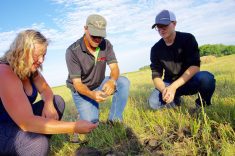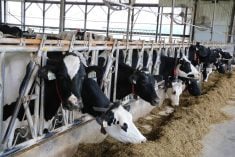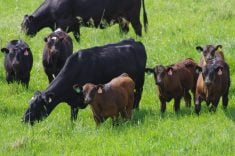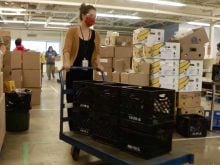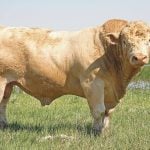Areas across Manitoba may be hard up for hay and feed, but those watching the market say there’s good supply available for purchase and prices have yet to rise significantly.
Ads for new-crop and carryover forage are plentiful, said John MacGregor, forage expert with the Manitoba Forage and Grassland Association, and prices have been fairly steady throughout the summer.
Why it matters: Patchy rains translated to patchy first cuts, but Manitoba will generally come into winter better off than more drought-stricken regions of the Prairies.
Read Also

Land agreement inked for Cereals Canada GATE facility
James Richardson & Sons, Limited will provide land for the Global Agriculture Technology Exchange (GATE) building in Winnipeg, according to memorandum of understanding with Cereals Canada
Producers who expect to be short on feed should source other supplies sooner rather than later, MacGregor advised.
The MFGA’s September hay update set alfalfa prices at eight to 11 cents per pound — slightly up from August, when alfalfa was going for six to 10 cents. Dairy quality alfalfa was unchanged during the period, with both months posting 10 to 12-cent prices.
Good quality alfalfa-grass mix was selling for six to 7.5 cents per pound in September, with beef quality going for five to seven cents, similar to August numbers.
In the lower quality spectrum, beef hay was selling for 3.5 to seven cents a pound in September, down from six to 9.5 cents a month earlier.
Final feed harvest
As of Sept. 24, corn silage harvest was well underway and some areas were finished, according to the last Manitoba Agriculture crop report of the month. Yields ranged from 13 to 15 tonnes per acre.
Beef producers were still working on the second cut of grass hay, the province said, and were cutting slough hay in some areas. A second alfalfa cut is also available for some producers, with fields more than three weeks past the critical harvest date set at the start of September.
In past seasons, producers might be on their third cut by the post-critical harvest window.
Forage growth on hay and pasture was mostly finished by late September, though MacGregor noted recent rains could green up some fields.
Parts of the northwest region had light frost as of the last crop report, sparking concern about nitrate concentrations in standing silage and greenfeed. Producers are advised to test annual crops for nitrates before feeding.
Straw baling was under way for bedding and cattle feed, the provincial crop report said. MacGregor said more beef producers are relying on straw for feed.
They should also grab straw for bedding while it’s plentiful, said Carson Callum, general manager for Manitoba Beef Producers.
Weather roller-coaster
The open question is, how far afield will producers have to go for winter feed this year?
Echoing a common theme of the 2023 growing season, farmers’ hay supply has been “based on where the thunderstorms hit,” MacGregor said.
Provincial data shows few areas of Manitoba had a normal amount of rain, and most are sitting well below average.
As of Sept. 24, the central region ranged from 34 per cent of normal precipitation at Cartwright to 67 per cent at Emerson, which was one of only three stations across the province to rise above the 60 per cent mark.
Manitoba Agriculture data shows the Altona and Gretna areas got nearly 27 and 34 millimetres, respectively, from Sept. 18-24.
In the southwest, precipitation records swing between 47 per cent of normal at Alexander and Findlay to 85 per cent at Deloraine. The northwest ranged between 48 per cent of normal at Keld to 80 per cent at Ethelbert.
The Interlake, in a break from past seasons as the dry nucleus of the province, received 57 per cent of normal at Stonewall and Arborg and 102 per cent of normal at Fisherton. The latter number may be deceiving. Provincial meteorologist Timi Ojo said in early September that the Fisherton station received 134 mm in one day rather than slow, soaking rains that provide more benefit to crops.
Despite patches of positive outlook, some producers struggled with conditions bad enough to prompt a Manitoba Beef Producers’ request that the province consider an AgriRecovery assessment, similar to requests made by Saskatchewan and Alberta this year.
Aid is in the works for both western Prairie provinces. In late August, Saskatchewan pledged up to $70 million to support livestock producers and Alberta is said to be drafting details of a program.
Around the same time, the federal government released an initial list of areas in B.C., Alberta, Saskatchewan and Manitoba eligible for the livestock tax deferral, a program that allows producers to push a portion of taxable income from the sale of breeding stock to the following year. Nineteen Manitoba municipalities made that list.
MBP wants the Manitoba government to ask for a smaller portfolio of aid than the rest of the Prairies, but Callum said it appears the province doesn’t think it is warranted.
Unlike the drought year of 2021, producers generally have carryover feed, Callum said. However, many will fine-tune rations and stretch feed as long as possible. If there isn’t much snow to provide insulation over the winter, next year could be “even more worrisome,” he said.
Some producers are also concerned about water levels, Callum noted. Several have applied for funds through the Resilient Agricultural Landscape Program and Sustainable Agriculture Manitoba program to improve dugouts or other water infrastructure.
They’re still waiting to hear if they’ll get that funding, said Callum, but the election may have delayed those decisions.




